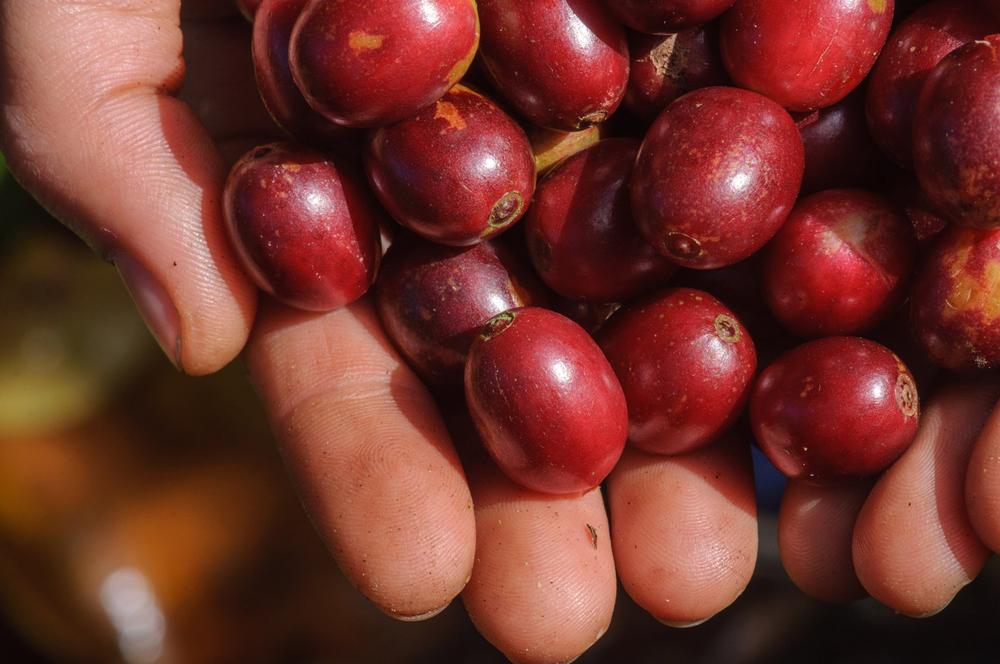Brief introduction of Organic Coffee beans and reasons for choosing Organic Coffee beans

For professional baristas, please follow the coffee workshop (Wechat official account cafe_style)
Organic coffee beans
Brief introduction of Organic Coffee beans
In many parts of the world, growers use pesticides to control the growth of coffee pests, and moist and foggy coffee at high altitudes are more vulnerable to pests, so growers often use pesticides to treat them. Many people believe that coffee can be called organic coffee beans as long as synthetic pesticides, herbicides and chemical fertilizers are not used during the growth of coffee. In fact, organic coffee beans can be called organic coffee beans only if they have been certified by third parties (except coffee producers and buyers).
Loving organic coffee beans
Organic Coffee Organic Coffee and authorized Organic Coffee Certified Organic Coffee is licensed by a third party and is grown without chemical raw materials without pesticides, pesticides, herbicides and artificial food additives during the growth of coffee trees. The detection, planting, cultivation, harvesting and production of soil water quality must meet the organic conditions and the process must be strictly controlled. It is a high-quality coffee produced in harmony with nature, which is of great benefit to health and environmental protection.
Only a small part of the world's coffee is truly organic certified coffee, because the certification process takes a long time, about three years. And such a deal could reduce coffee production by as much as 50%. So when coffee growers decide to do organic certification, it means that a time-consuming and costly investment begins.
Organic coffee does not use any insecticides or other chemicals to treat pests or cultivation problems, but uses natural methods, such as natural composting, hedgerows, pruning, etc., to maintain the growth of coffee trees; use all-natural biological control methods in pest control, such as planting protective trees, and use various other natural farming techniques to ensure the health of coffee trees. Because the sustainability of land, water and the natural ecological environment is an active concern of the organic coffee industry.
Organic high-quality coffee is a masterpiece of heaven, earth, and man-weather, soil, and love. It takes five years for a coffee tree to blossom and bear fruit. A pound of coffee needs about 4000 coffee beans, which are harvested manually. Each coffee tree harvests only enough coffee fruit a year to produce a pound of roasted beans, which is rare.
Reasons for choosing organic coffee beans
1. Protect the next generation: reduce exposure to carcinogenic chemicals such as pesticides and herbicides.
two。 Prevent soil exhaustion: according to the soil Conservation Society, soil loss is seven times higher than recovery since chemicals are used and plants that nourish the soil are destroyed.
3. Energy conservation: modern farming is suitable for planting and harvesting crops with petroleum artificial fertilizers.
4. Say no to chemicals: EPA has confirmed that 60% of herbicides, 90% of fungicides and 30% of pesticides are carcinogens. All of these substances can cause cancer and deformities in babies.
5. Protecting farmers: protecting the health of farmers is also one of the responsibilities of society. We must reduce the possibility of farmers being exposed to chemicals. In the third world, the safety of the use of pesticides has been paid less attention, which has gradually become a serious problem.
classification
● grade, specification
At present, each producing country has its own independent standards. The most commonly adopted criteria are as follows:
A: washing / non-washing
B: flat beans / round beans
C: filter screen (size of coffee beans) reference Table 1
C classification is adopted in most countries, such as Brazil, Colombia, Tanzania and so on. Although there may not be an absolute relationship between the size and quality of coffee beans, it can make the size of raw coffee beans the same.
D: according to the elevation classification reference table 2, according to the elevation of the cultivated land, it can be divided into three, four, seven and other grades (different national standards). For example, Mexico and Honduras adopt three grades, while Guatemala adopts seven grades. Generally speaking, the quality of highland beans is better than that of lowland beans, and the price is higher because of the increase in freight.
E: quality Typ
The type and quantity of blends (defective beans) contained in a certain amount of samples are converted into "defective number", and a certain sum is taken as the basis for determining the type of quality. Brazil, Ethiopia, Cuba, Peru and other countries all have benchmarks for the number of defects, and the smaller the value, the better.
F: set specifications according to taste
Brazil, Haiti, Kenya, Zaire and other countries all have their own taste testing methods, which can be exported only after taste testing.
Name of ● exporter
The name of the ship, export industry, etc., that exports coffee beans.
Check the raw coffee beans by hand. It is also very important to refer to the markings of origin and specifications and touch them directly with your hands to observe their appearance and feeling. To judge the quality of raw coffee beans by their appearance, you must have a certain degree of experience, but as long as the type is certain, you will be able to handle it easily.
● color is spotless, light green and bright, for the beautiful color of coffee beans, which is also related to the harvest.
The ● shape uses coffee beans of the same size to avoid deformed beans and remove them even if there is a small amount of them.
● raw coffee beans have a unique bright green, which does not necessarily mean that they have a good taste, but can be proved to be fresh agricultural products. In addition to the original fragrance, it should also be noted that it may be contaminated with other peculiar smells (such as fermentation, mildew, medicinal smell, fishy smell, etc.).
● defective beans, such as moth-eaten coffee beans, immature, fermented, shell beans, chopped beans, etc., can be inspected by appearance.
The origin of ● coffee
Today, there are more than 100 varieties of coffee, but these more than 100 kinds of coffee are all derived from Arabica coffee, Robbda coffee and Liberian coffee, which come from different countries as follows:
Brazil
The largest coffee producer, which accounts for 1/3 of the world's coffee consumption, accounts for 1/3 of the world's coffee consumption and has a place in the global coffee market, although Brazil faces several times more natural disasters than other regions. but its acreage is enough to make up for it.
There are many kinds of coffee here, but its industrial policy is large and cheap, so there is not much premium coffee, but it is a good choice for mixing other coffees.
One of the most famous is Sandos Coffee, which tastes mellow and neutral. It can be boiled directly or mixed with other kinds of coffee beans to form a mixed coffee. It is also a good choice. Other kinds of Brazilian coffee, such as Rio and Parana, can be produced in large quantities because they do not need too much care. Although the taste is rough, it is a kind of coffee with good quality and low price.
Colombia
It is also Colombia, the second largest coffee industry after Brazil. Leaders in the Maird Group (Colombia, Tanzania, Kenya). The Maird Group is one of the categories of origin on the New York Stock Exchange, in addition to Asa? Maird, Antwor Sheppard? Arabica, Robusta). The more famous producing areas, such as "Medellin", "Manizares", "Bogota" and "Armenia", etc., all the coffee beans cultivated are Anicabi species, which are quite rich in taste and stable in quality and price. The fried coffee beans are even bigger and more beautiful. From low-grade products to high-grade products can be produced, some of which are rare good goods in the world, the taste is so mellow that people can't put it down.
Cuban Crystal Mountain
It is famous for its mellow and fragrant taste. Crystal Mountain is adjacent to the Blue Mountain Mountains of Jamaica, with similar climatic conditions, comparable to Jamaican Blue Mountain Coffee. Represented by "Cubita Coffee", it is a special coffee bean among the island beans and is known as the unique Caribbean flavor coffee.
Mexico
This major coffee producer in Central America, the coffee here is comfortable and charming. The Mexican coffee selected are Coatepec, Huatusco and Orizaba, among which Cottpe is considered to be one of the best in the world.
Hawaii
To visit Hawaii, in addition to the beautiful beach, don't forget the Hawaiian coffee bean-Kona. The palate is sweet with the acidity of a pleasant wine, very special. It is Kona, which is produced on the southwest coast of Hawaii, which is the most traditional and famous coffee in Hawaii. However, because the production here is not high, the cost is surprisingly high, and the demand for individual coffee in the United States and other places is increasing, so its unit price is not only getting higher and higher, but also not easy to buy.
Indonesia
When it comes to Indonesian coffee, we must not miss the high-end Mantenin of Sumatra, which has a unique fragrant taste, slightly acidic taste and can be said to be the best in the world. In addition, Arabian coffee produced in Java is the favorite of Europeans, which is sweet in bitterness and sour in the middle of it, which lasts for a long time.
Costa Rica
The coffee beans produced at the high latitudes of Costa Rica are famous in the world, full-bodied, mild in taste, but extremely sour. The coffee beans here have been carefully processed, which is why they have high quality coffee. The famous coffee is produced in the Central Plateau (Central Plateau), where the soil consists of successive layers of volcanic ash and dust.
Angola
This is the fourth largest coffee industry in the world, but it produces only a small amount of Arabian coffee, which is of high quality, but unfortunately, its annual output is extremely unstable due to its political upheaval.
Ethiopia
Arabian coffee is the hometown of Arabian coffee, which grows at high latitudes and needs a lot of manual care. Here is the famous Ethiopian mocha, which is sour, fragrant and productive similar to wine. Unfortunately, some farmers still do not understand the benefits of picking fruit and allow them to fall behind and pick it up from the ground, but in recent years, due to the continuous expansion of the market, coffee industry is committed to improving harvesting and processing methods, hoping to increase production.
Jamaica
Jamaica's national treasure, Blue Mountain Coffee, is perfect in all respects, just like wine, many wineries are now bought by the Japanese. The Japanese have bought most of the Jamaican coffee in recent years, so it is very difficult to buy it in the market. It is said that it has not been available in Britain for four years, and the spending power of Easterners is really staggering.
Kenya
Kenya grows high-quality Arabica coffee beans, which absorb almost the essence of coffee cherries and are very popular among Europeans because of their slightly sour and thick aroma. Especially in Britain, Kenyan coffee surpasses Costa Rican coffee and becomes one of the most popular coffee.
Yemen
Yemeni mocha coffee was once all the rage, blowing a whirlwind of mocha all over the world, but unfortunately, the good times are not very good. Under the political turmoil and unplanned cultivation, the production of mocha is very unstable. Having said that, mocha is still the soul of matching other coffee beans or mixed coffee beans.
Peru
Peruvian coffee, a rising star, is gradually opening up its popularity and entering the world. It is mostly planted in high-altitude areas, the planned planting makes the yield greatly increased, the taste mellow, the right acidity, more and more people like it.
How to choose organic coffee beans
Choose fresh coffee beans.
When buying, pay attention to whether the color of the beans and the size of the particles are the same. Good coffee beans are shiny and have a strong aroma without being mixed with peculiar smell.
No matter what kind of coffee beans, freshness is an important factor affecting the quality.
When shopping, grab one or two coffee beans in your mouth and chew them with a crisp sound (indicating that the coffee is not damp) and the fragrance of the teeth and cheeks is the top grade, but it is best to squeeze it with your hands to feel whether it is solid, rather than buying crispy coffee.
If the coffee bean has lost its fragrance or smells stale, it means that the coffee bean is no longer fresh and is not suitable for purchase.
Freshly fried coffee beans are not suitable for immediate consumption and should be stored for a week to completely release the gas from the beans.
Generally speaking, the best drinking period for coffee is a week after stir-frying, when the coffee beans are the freshest and the Aroma taste is the best.
In addition, the purity of coffee beans is also another consideration. The expert candidate for coffee is not necessarily to look at the size of the particles, but to grab a handful of individual coffee beans (Regional Coffee), about dozens of portions, to see whether the color of each single bean is the same, and whether the particles are similar in size and shape, so as to avoid buying shoddy products disguised as mixed beans.
But if it is a synthetic bean (Blended Coffee), it is a normal phenomenon that the size and color are different. In addition, heavy heat and medium-deep roasting will cause coffee beans to produce oil, but if the lightly roasted beans produce oil, they have gone bad, not only reducing aroma, but also astringent and sour taste. In short, when buying coffee, we should pay attention to its freshness, aroma and whether it is stale or not, and the ideal purchase quantity is to be able to drink it in half a month.
Important Notice :
前街咖啡 FrontStreet Coffee has moved to new addredd:
FrontStreet Coffee Address: 315,Donghua East Road,GuangZhou
Tel:020 38364473
- Prev

Two or three things about Coffee-- on the necessity of stable sample Bean Dryer
For the exchange of professional baristas, please follow the coffee workshop (Wechat official account cafe_style). The 2017 GEISHA of Panama's Jade Manor has just ended. This time point in summer is the season for shipping after harvesting and processing in each coffee producing area. The continuous sharing of raw beans is the most exciting activity unique to coffee people this season, and the bidding for all kinds of exquisite coffee beans will attract attention.
- Next

The baking preference of cities all over the world
For the exchange of professional baristas, please pay attention to the coffee workshop (Wechat official account cafe_style). Cities around the world have their own preference for roasting. In Tokyo, micro-deep medium baking is more popular, but slowly it also tends to deep baking. As for Kansai, deep baking has been popular in the past. New York, as its name suggests, generally prefers urban baking, but because
Related
- Beginners will see the "Coffee pull flower" guide!
- What is the difference between ice blog purified milk and ordinary milk coffee?
- Why is the Philippines the largest producer of crops in Liberia?
- For coffee extraction, should the fine powder be retained?
- How does extracted espresso fill pressed powder? How much strength does it take to press the powder?
- How to make jasmine cold extract coffee? Is the jasmine + latte good?
- Will this little toy really make the coffee taste better? How does Lily Drip affect coffee extraction?
- Will the action of slapping the filter cup also affect coffee extraction?
- What's the difference between powder-to-water ratio and powder-to-liquid ratio?
- What is the Ethiopian local species? What does it have to do with Heirloom native species?

